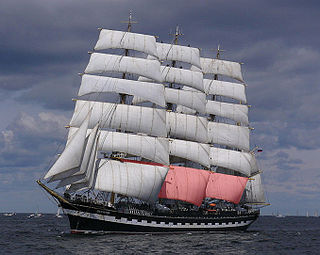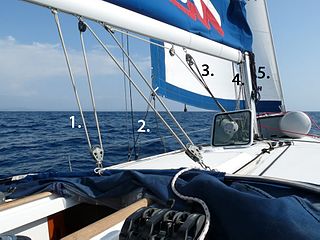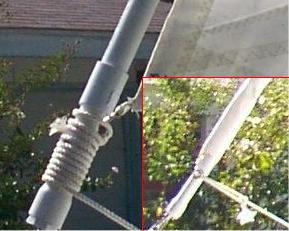
Sailing rigs describe the arrangement of sailing vessels' rig components, including their spars, rigging, and sails. Examples include a schooner rig, cutter rig, junk rig, etc. Rigs may be broadly categorized as fore-and-aft and square-rigged. They may incorporate a mixture of both categories. Within the fore-and-aft category there is a variety of triangular and quadrilateral sail shapes. Spars or battens may be used to help shape a given kind of sail. Each rig may be described with a sail plan—formally, a drawing of a vessel, viewed from the side.

A jibe (US) or gybe (Britain) is a sailing maneuver whereby a sailing vessel reaching downwind turns its stern through the wind, which then exerts its force from the opposite side of the vessel. Because the mainsail boom can swing across the cockpit quickly, jibes are potentially dangerous to person and rigging compared to tacking. Therefore accidental jibes are to be avoided while the proper technique must be applied so as to control the maneuver. For square-rigged ships, this maneuver is called wearing ship.

In sailing, a cunningham or cunningham's eye is a type of downhaul used on a Bermuda rigged sailboat to change the shape of a sail. It is named after its inventor, Briggs Cunningham, a victorious America's Cup skipper and yacht builder.

A mainsail is a sail rigged on the main mast of a sailing vessel.

Running rigging is the rigging of a sailing vessel that is used for raising, lowering, shaping and controlling the sails on a sailing vessel—as opposed to the standing rigging, which supports the mast and bowsprit. Running rigging varies between vessels that are rigged fore and aft and those that are square-rigged.

A Bermuda rig, Bermudian rig, or Marconi rig is a configuration of mast and rigging for a type of sailboat and is the typical configuration for most modern sailboats. This configuration was developed in Bermuda in the 1600s; the term Marconi, a reference to the inventor of the radio, Guglielmo Marconi, became associated with this configuration in the early 1900s because the wires that stabilize the mast of a Bermuda rig reminded observers of the wires on early radio masts.

Sail components include the features that define a sail's shape and function, plus its constituent parts from which it is manufactured. A sail may be classified in a variety of ways, including by its orientation to the vessel and its shape,. Sails are typically constructed out of flexible material that is shaped by various means, while in use, to offer an appropriate airfoil, according to the strength and apparent direction of the wind. A variety of features and fittings allow the sail to be attached to lines and spars.

Gunter rig is a configuration of sail and spars used in sailing. It is a fore and aft sail set abaft (behind) the mast. The lower half of the luff (front) of the sail is attached to the mast, and the upper half is fastened to a spar which is approximately vertical and reaches above the top of the mast. This spar is called a "yard", but it is common for some to confuse it with a "gaff". The overall shape of a gunter sail is roughly triangular, so having a superficial resemblance to Bermuda rig.

A derrick is a lifting device composed at minimum of one guyed mast, as in a gin pole, which may be articulated over a load by adjusting its guys. Most derricks have at least two components, either a guyed mast or self-supporting tower, and a boom hinged at its base to provide articulation, as in a stiffleg derrick. The most basic type of derrick is controlled by three or four lines connected to the top of the mast, which allow it both to move laterally and cant up and down. To lift a load, a separate line runs up and over the mast with a hook on its free end, as with a crane.

In sailing, a boom is a spar (pole), along the of a fore and aft rigged sail, that greatly improves control of the angle and shape of the sail. The primary action of the boom is to keep the foot flatter when the sail angle is away from the centerline of the boat. The boom also serves as an attachment point for more sophisticated control lines. Because of the improved sail control it is rare to find a non-headsail without a boom, but lateen sails, for instance, are loose-footed. In some modern applications, the sail is rolled up into the boom for storage or reefing.

Reefing reduces the area of a sail, usually by folding or rolling one edge of the canvas in on itself and attaching the unused portion to a spar or a stay, as the primary measure to preserve a sailing vessel's stability in strong winds. Restoring full sail area is termed shaking out a reef.
Running backstays support the headstay in a fractionally rigged boat. A masthead rig has the advantage of not needing them. A running backstay runs from each lateral corner of the stern to the mast at the level where the forestay begins in the fractional rig. Together with other rigging, it supports the mast. Because they are attached low on the mast, they can present a significant problem in an accidental gybe, as the boom hits the stay, with the possibility of breaking the boom, mast, or both.

The spritsail is a four-sided, fore-and-aft sail that is supported at its highest points by the mast and a diagonally running spar known as the sprit. The foot of the sail can be stretched by a boom or held loose-footed just by its sheets. A spritsail has four corners: the throat, peak, clew, and tack. The Spritsail can also be used to describe a rig that uses a spritsail.

The junk rig, also known as the Chinese lugsail, Chinese balanced lug sail, or sampan rig, is a type of sail rig in which rigid members, called battens, span the full width of the sail and extend the sail forward of the mast.
A mast-aft rig is a sailboat sail-plan that uses a single mast set in the aft half of the hull. The mast supports fore-sails that may consist of a single jib, multiple staysails, or a crab claw sail. The mainsail is either small or completely absent. Mast-aft rigs are uncommon, but are found on a few custom, and production sailboats.

Roller furling is a method of furling a yacht's staysail by rolling the sail around a stay. Roller furling is typically used for foresails such as jibs or genoas.

A jibboom is a spar used to extend the length of a bowsprit on sailing ships. It can itself be extended further by a flying jib-boom. The heel end of the flying jib-boom is attached to the jib-boom, and the heel of the jib-boom to the bowsprit. The point of the flying jib-boom is generally the fore-most extent of a ship. The jib- and flying jib- booms carry the tacks of the jib and flying jib sails, respectively, and the stay for the fore topgallant mast and the royal stay.

Ljungström sailboats were created by the Swedish engineer Fredrik Ljungström, who was interested in sailing since childhood. A "Ljungström sailboat" typically has a "circular arc" hull and a "Ljungström rig". A Ljungström rig mast has no mast stays. The mast rotates on two ball bearings often flying double mainsails, with no foresails. In their time the Ljungström sailboats were a minor revolution as they were fast, safe and easy to sail as well as relatively easy and affordable to produce.

A sail is a tensile structure—which is made from fabric or other membrane materials—that uses wind power to propel sailing craft, including sailing ships, sailboats, windsurfers, ice boats, and even sail-powered land vehicles. Sails may be made from a combination of woven materials—including canvas or polyester cloth, laminated membranes or bonded filaments—usually in a three- or four-sided shape.

The lug sail, or lugsail, is a fore-and-aft, four-cornered sail that is suspended from a spar, called a yard. When raised, the sail area overlaps the mast. For "standing lug" rigs, the sail may remain on the same side of the mast on both the port and starboard tacks. For "dipping lug" rigs, the sail is lowered partially or totally to be brought around to the leeward side of the mast in order to optimize the efficiency of the sail on both tacks.



















